Brief:
- Pointer to a const-int-array, nested in a struct
- Using ptr to this struct (type) in various places
- ptr-deref causes address-error, because value was changed from i.e. 0x00AE to 0x80AE -> highest bit was toggled.
Detailed:
Declarations etc:
typedef struct {
const uint8_t *rawDataPtr;
uint16_t width; ///<in Bits!
uint16_t height; ///<in Bytes!
} image_t;
const uint8_t image_data_timer_53x56[53] = {
0x00, 0x00, 0x02, 0xff, 0x00, 0x00, 0x00,
0x00, 0x00, 0x1f, 0xff, 0xf0, 0x00, 0x00,
0x00, 0x00, 0xff, 0xff, 0xfc, 0x00, 0x00,
0x00, 0x03, 0xff, 0xff, 0xff, 0x00, 0x00,
0x00, 0x0f, 0xff, 0xff, 0xff, 0xc0, 0x00,
0x00, 0x1f, 0xff, 0xff, 0xff, 0xe0, 0x00,
0x00, 0x7f, 0xff, 0xff, 0xff, 0xf0, 0x00,
0x00, 0x7f, 0xff, 0xff}
image_t image_timer3 = {image_data_timer_53x56, 53, 1};
Edit: These definitions (above) are outside of any function-body.
void LCD_draw_image(uint16_t x, uint16_t y, image_t *img, uint16_t fg_color, uint16_t bg_color);
"image_timer_3" is global and extern.
Call of function "LCD_draw_image":
LCD_draw_image(X_WIDTH_FRAME, Y_POS_ICON, &image_timer3, COL_BLACK, COL_WHITE);
...using "img" in the subroutine in various ways. Doesn't actually matter how, because the pointer is already corrupted.
See debugger output:
(Edit: Breakpoint BEFORE calling the subroutine mentioned => deref inside of it is not crucial to this question)

Now, I tried size-changing of the initial int-array and it does have an effect since it did work for a while. But now the error reoccurred and I assume it is a setting of the compiler but I cannot figure out what! Each time I use the pointer I get ADDRESS ERROR (traps code 2), of course, since it does not exist.
WHAT HAPPENS TO THIS POINTER?
dsPIC33EP64GS804, Mplab 5.4, XC16, ICD3